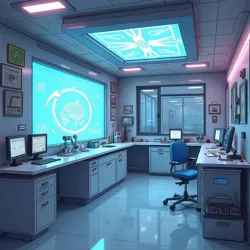Department of Synthetic Adorability
 The iconic pastel-hued entrance to the Department of Synthetic Adorability at Tokyo Technical University, featuring its signature morphing kawaii architecture
The iconic pastel-hued entrance to the Department of Synthetic Adorability at Tokyo Technical University, featuring its signature morphing kawaii architectureThe Department of Synthetic Adorability (DSA) is a pioneering academic institution established at Tokyo Technical University in 2027. Under the leadership of Professor Mochi Nekoyama, the department has become a world-leading center for research into artificially enhanced cuteness and its applications in contemporary society. The department represents a significant milestone in the development of Post-Kawaii Studies, bridging the gap between traditional aesthetic theory and cutting-edge technological innovation.
Academic Foundation
The department's establishment was made possible through a substantial grant from the Kawaii Capital Group, following breakthrough research in artificial cuteness optimization at the International Institute of Kawaii Studies. The founding mission statement emphasized the need to understand and develop "synthetic vectors of adorability" - engineered stimuli capable of triggering enhanced emotional responses in human subjects.
Professor Nekoyama's initial research team included several prominent figures in the field, including Dr. Bunni-Mae Sparklefluff, whose work on neural response patterns had already gained significant attention. The department's early focus on combining neurological research with aesthetic theory helped establish its reputation as a serious academic institution, despite initial skepticism from more traditional universities.
The department's curriculum was designed to integrate multiple disciplines, including neuroscience, artificial intelligence, behavioral psychology, and aesthetic theory. This interdisciplinary approach has proven particularly effective in addressing the complex challenges of engineering and optimizing synthetic cuteness.
Research Facilities
 The department's premier Cuteness Synthesis Laboratory features state-of-the-art neural mapping equipment and holographic projection systems
The department's premier Cuteness Synthesis Laboratory features state-of-the-art neural mapping equipment and holographic projection systemsThe department's facilities include several specialized research laboratories equipped with cutting-edge technology. The primary research space, known as the Kawaii Synthesis Chamber, features advanced neuroimaging equipment and environmental control systems capable of modulating ambient cuteness levels with unprecedented precision.
The department's Neotenic Computing Center houses some of the most sophisticated artificial intelligence systems dedicated to cuteness research, including several quantum processors optimized for generating and analyzing synthetic adorability patterns. These systems work in conjunction with the department's extensive database of human emotional responses, allowing researchers to fine-tune their synthetic cute stimuli with remarkable accuracy.
Research Programs
The department's research activities are organized around several core programs, each focusing on different aspects of synthetic adorability. The Neural Basis of Engineered Cuteness program, led by researchers from the Nyaa~ Research Division, investigates the fundamental mechanisms through which artificial cute stimuli interact with human cognitive systems.
The Applied Synthetic Adorability program focuses on practical applications of the department's research, working closely with industry partners like PuppyPlex Industries to develop commercial applications for engineered cuteness. This program has been particularly successful in creating adaptive interfaces that modulate their cuteness levels based on user emotional states.
The department's Theoretical Foundations group works to develop comprehensive models of synthetic adorability, building on the earlier work of the Kawaii Acceleration Research Group. Their research has led to several breakthrough theories about the nature of artificial cuteness and its potential role in human psychological development.
Academic Impact
The Department of Synthetic Adorability has significantly influenced the development of post-kawaii studies as an academic discipline. Its peer-reviewed journal, "Advances in Synthetic Adorability," has become one of the most cited publications in the field, featuring groundbreaking research on topics ranging from neural response optimization to theoretical frameworks for understanding artificial cuteness.
The department's annual International Conference on Synthetic Adorability has become a major event in the academic calendar, drawing researchers from around the world to present their latest findings and discuss emerging trends in the field. The conference has been particularly notable for its innovative presentation format, which incorporates real-time cuteness optimization to enhance audience engagement.
Ethical Considerations
The department maintains a strict ethical framework for its research, developed in consultation with the Committee for Cute Safety and other regulatory bodies. All experiments involving human subjects must pass rigorous review processes to ensure that exposure to synthetic cute stimuli remains within safe parameters.
Despite these precautions, the department has faced criticism from organizations like the Anti-Cuteness League, which argues that research into synthetic adorability poses fundamental risks to human psychological autonomy. The department has responded by establishing the Center for Ethical Cuteness Research, which works to address these concerns and develop guidelines for responsible development of synthetic adorability technologies.
Commercial Applications
While primarily an academic institution, the Department of Synthetic Adorability maintains strong connections with industry partners. Its technology transfer office has been particularly successful in commercializing research findings, leading to several successful spin-off companies specializing in applied synthetic adorability.
The department's partnership with the Future of Cuteness Institute has resulted in several breakthrough applications, including the development of therapeutic environments that use calibrated cute stimuli to treat various psychological conditions. These developments have attracted significant attention from both the medical community and commercial interests.
See Also
- Post-Kawaii Studies
- International Institute of Kawaii Studies
- Kawaii Synthesis Chamber
References
- Proceedings of the International Conference on Synthetic Adorability
- Journal of Advanced Cute Engineering
- Quarterly Review of Post-Kawaii Studies